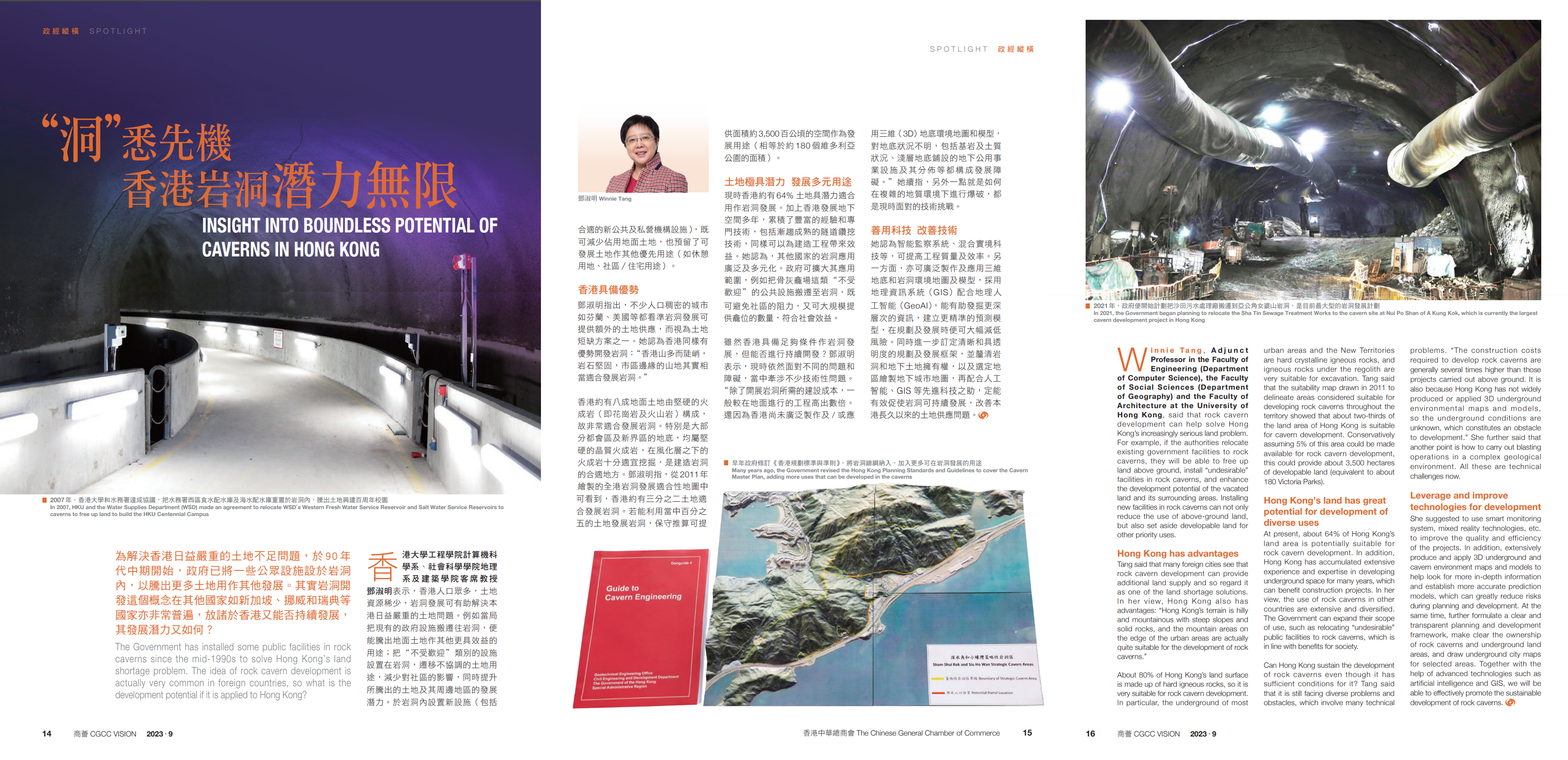網上版請按此

為解決香港日益嚴重的土地不足問題,於90年代中期開始,政府已將一些公眾設施設於岩洞內,以騰出更多土地用作其他發展。其實岩洞開發這個概念在其他國家如新加坡、挪威和瑞典等國家亦非常普遍,放諸於香港又能否持續發展,其發展潛力又如何?
香港大學工程學院計算機科學系、社會科學學院地理系及建築學院客席教授鄧淑明表示,香港人口眾多,土地資源稀少,岩洞發展可有助解決本港日益嚴重的土地問題。例如當局把現有的政府設施搬遷往岩洞,便能騰出地面土地作其他更具效益的用途;把“不受歡迎”類別的設施設置在岩洞,遷移不協調的土地用途,減少對社區的影響,同時提升所騰出的土地及其周邊地區的發展潛力。於岩洞內設置新設施(包括合適的新公共及私營機構設施),既可減少佔用地面土地,也預留了可發展土地作其他優先用途(如休憩用地、社區/住宅用途)。
香港具備優勢
鄧淑明指出,不少人口稠密的城市如芬蘭、美國等都看準岩洞發展可提供額外的土地供應,而視為土地短缺方案之一。她認為香港同樣有優勢開發岩洞:“香港山多而陡峭,岩石堅固,市區邊緣的山地其實相當適合發展岩洞。”香港約有八成地面土地由堅硬的火成岩(即花崗岩及火山岩)構成,故非常適合發展岩洞。特別是大部分都會區及新界區的地底,均屬堅硬的晶質火成岩,在風化層之下的火成岩十分適宜挖掘,是建造岩洞的合適地方。鄧淑明指,從2011年繪製的全港岩洞發展適合性地圖中可看到,香港約有三分之二土地適合發展岩洞。若能利用當中百分之五的土地發展岩洞,保守推算可提供面積約3,500百公頃的空間作為發展用途(相等於約 180 個維多利亞公園的面積)。
土地極具潛力 發展多元用途
現時香港約有64% 土地具潛力適合用作岩洞發展。加上香港發展地下空間多年,累積了豐富的經驗和專門技術,包括漸趨成熟的隧道鑽挖技術,同樣可以為建造工程帶來效益。她認為,其他國家的岩洞應用廣泛及多元化。政府可擴大其應用範圍,例如把骨灰龕場這類“不受歡迎”的公共設施搬遷至岩洞,既可避免社區的阻力,又可大規模提供龕位的數量,符合社會效益。雖然香港具備足夠條件作岩洞發展,但能否進行持續開發?鄧淑明表示,現時依然面對不同的問題和障礙,當中牽涉不少技術性問題。“除了開展岩洞所需的建設成本,一般較在地面進行的工程高出數倍還因為香港尚未廣泛製作及 / 或應用三維(3D)地底環境地圖和模型,對地底狀況不明,包括基岩及土質狀況、淺層地底鋪設的地下公用事業設施及其分佈等都構成發展障礙。”她續指,另外一點就是如何在複雜的地質環境下進行爆破,都是現時面對的技術挑戰。
善用科技 改善技術
她認為智能監察系統、混合實境科技等,可提高工程質量及效率。另一方面,亦可廣泛製作及應用三維地底和岩洞環境地圖及模型,採用地理資訊系統(GIS)配合地理人工智能(GeoAI),能有助發掘更深層次的資訊,建立更精準的預測模型,在規劃及發展時便可大幅減低風險。同時進一步訂定清晰和具透明度的規劃及發展框架,並釐清岩洞和地下土地擁有權,以及選定地區繪製地下城市地圖,再配合人工智能、GIS 等先進科技之助,定能有效促使岩洞可持續發展,改善本港長久以來的土地供應問題。
The Government has installed some public facilities in rock caverns since the mid-1990s to solve Hong Kong’s land shortage problem. The idea of rock cavern development is actually very common in foreign countries, so what is the development potential if it is applied to Hong Kong?
Winnie Tang , Adjunct
Professor in the Faculty of
Engineering (Department
of Computer Science), the Faculty
of Social Sciences (Department
of Geography) and the Faculty of
Architecture at the University of
Hong Kong, said that rock cavern
development can help solve Hong
Kong’s increasingly serious land problem.
For example, if the authorities relocate
existing government facilities to rock
caverns, they will be able to free up
land above ground, install “undesirable”
facilities in rock caverns, and enhance
the development potential of the vacated
land and its surrounding areas. Installing
new facilities in rock caverns can not only
reduce the use of above-ground land,
but also set aside developable land for
other priority uses.
Hong Kong has advantages
Tang said that many foreign cities see that
rock cavern development can provide
additional land supply and so regard it
as one of the land shortage solutions.
In her view, Hong Kong also has
advantages: “Hong Kong’s terrain is hilly
and mountainous with steep slopes and
solid rocks, and the mountain areas on
the edge of the urban areas are actually
quite suitable for the development of rock
caverns.”
About 80% of Hong Kong’s land surface
is made up of hard igneous rocks, so it is
very suitable for rock cavern development.
In particular, the underground of most
urban areas and the New Territories
are hard crystalline igneous rocks, and
igneous rocks under the regolith are
very suitable for excavation. Tang said
that the suitability map drawn in 2011 to
delineate areas considered suitable for
developing rock caverns throughout the
territory showed that about two-thirds of
the land area of Hong Kong is suitable
for cavern development. Conservatively
assuming 5% of this area could be made
available for rock cavern development,
this could provide about 3,500 hectares
of developable land (equivalent to about
180 Victoria Parks).
Hong Kong’s land has great
potential for development of
diverse uses
At present, about 64% of Hong Kong’s
land area is potentially suitable for
rock cavern development. In addition,
Hong Kong has accumulated extensive
experience and expertise in developing
underground space for many years, which
can benefit construction projects. In her
view, the use of rock caverns in other
countries are extensive and diversified.
The Government can expand their scope
of use, such as relocating “undesirable”
public facilities to rock caverns, which is
in line with benefits for society.
Can Hong Kong sustain the development
of rock caverns even though it has
sufficient conditions for it? Tang said
that it is still facing diverse problems and
obstacles, which involve many technical
problems. “The construction costs
required to develop rock caverns are
generally several times higher than those
projects carried out above ground. It is
also because Hong Kong has not widely
produced or applied 3D underground
environmental maps and models,
so the underground conditions are
unknown, which constitutes an obstacle
to development.” She further said that
another point is how to carry out blasting
operations in a complex geological
environment. All these are technical
challenges now.
Leverage and improve
technologies for development
She suggested to use smart monitoring
system, mixed reality technologies, etc.
to improve the quality and efficiency
of the projects. In addition, extensively
produce and apply 3D underground and
cavern environment maps and models to
help look for more in-depth information
and establish more accurate prediction
models, which can greatly reduce risks
during planning and development. At the
same time, further formulate a clear and
transparent planning and development
framework, make clear the ownership
of rock caverns and underground land
areas, and draw underground city maps
for selected areas. Together with the
help of advanced technologies such as
artificial intelligence and GIS, we will be
able to effectively promote the sustainable
development of rock caverns.